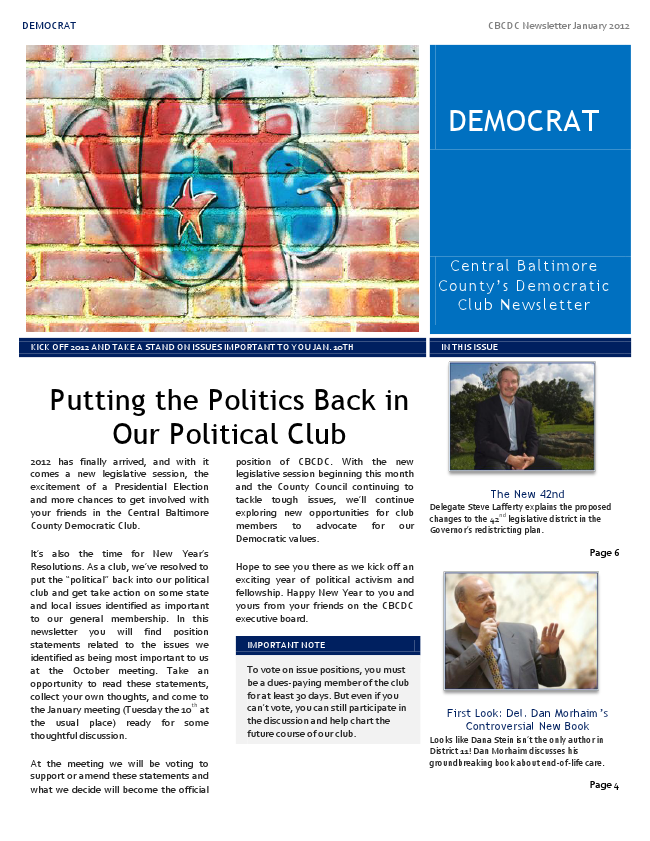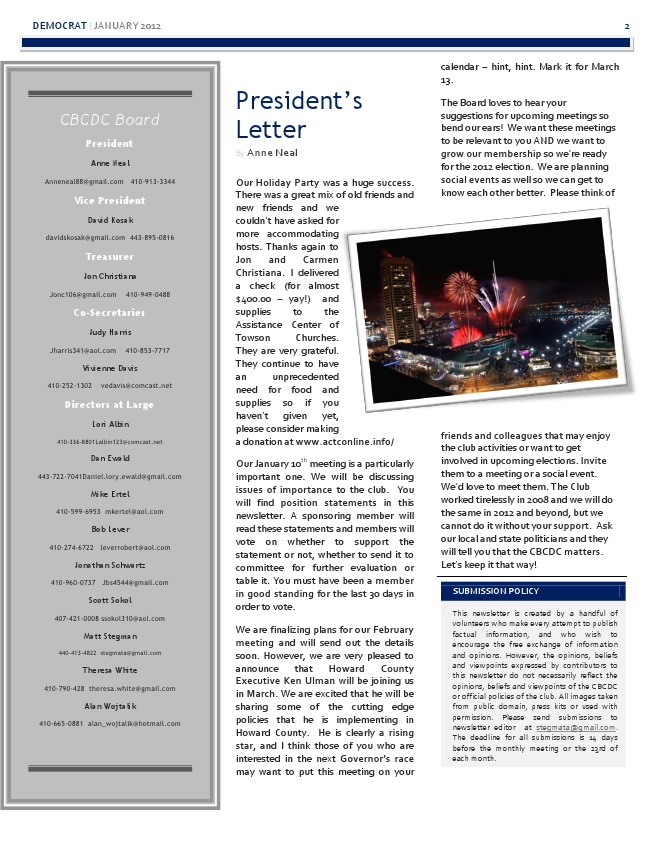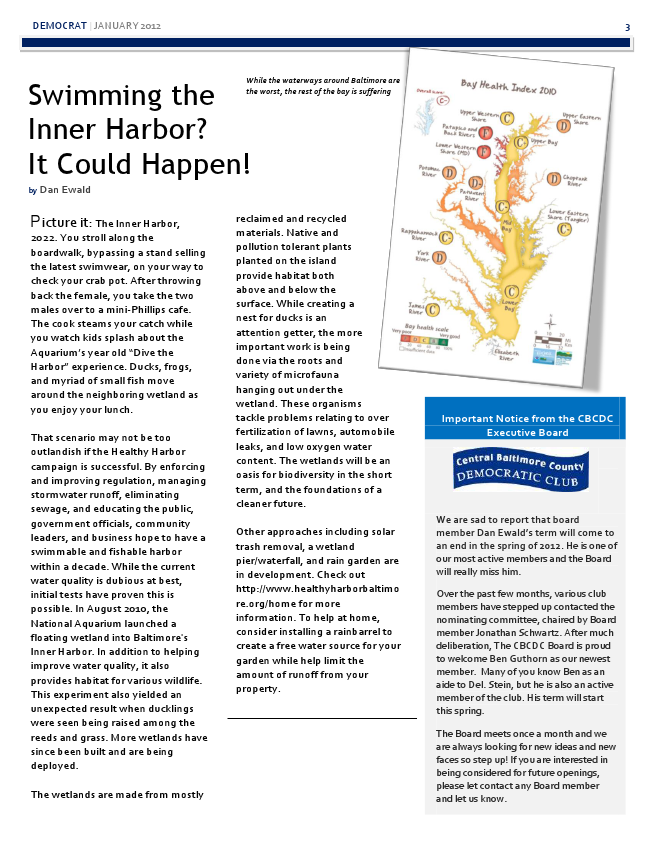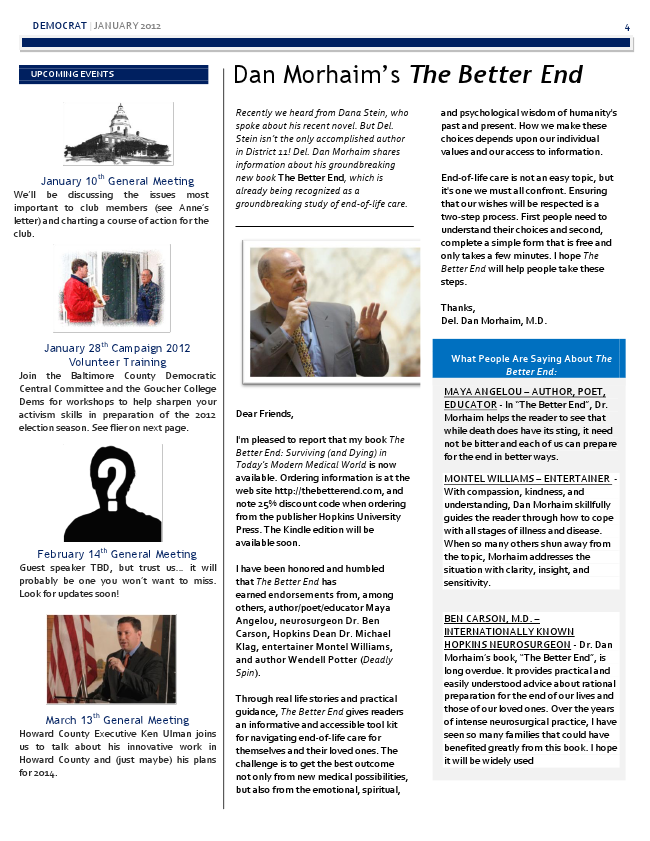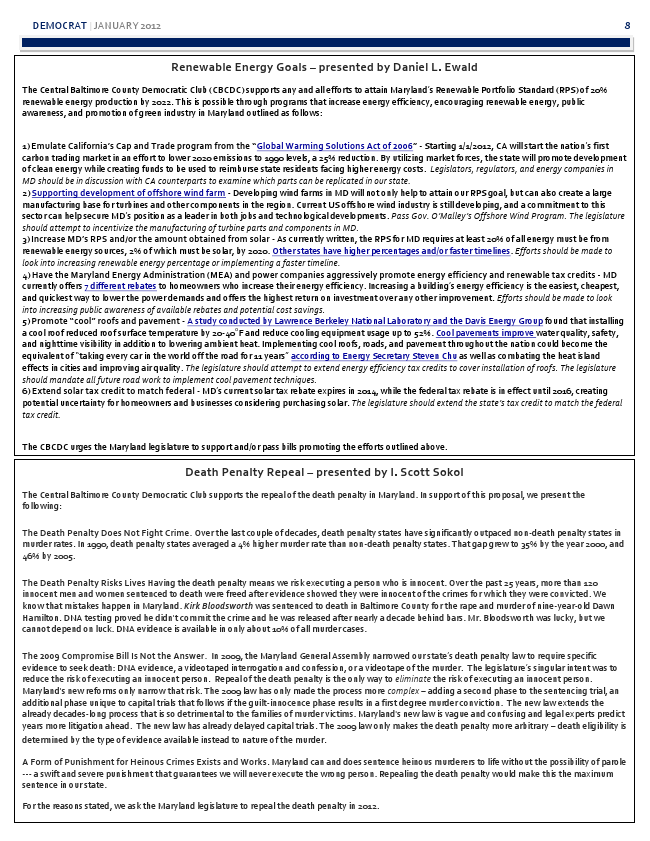| January Newsletter: Political Issues Edition | <– Date –> <– Thread –> |
|
From: Central Baltimore County Democratic Club (cbcdc |
|
| Date: Thu, 5 Jan 2012 20:20:55 -0800 (PST) | |
The JANUARY 2012 CBCDC Newsletter is now available! Packed with Great Info! Click on the link below to open the newsletter as a PDF file or SCROLL DOWN to view images. http://www.cbcdc.org/newsletters/CBCDC_Newsletter_January.pdf · Next meeting 1/10/12: Putting the Politics Back in Our Political Club 2012 has finally arrived, and with it comes a new legislative session, the excitement of a Presidential Election and more chances to get involved with your friends in the Central Baltimore County Democratic Club. It’s also the time for New Year’s Resolutions. As a club, we’ve resolved to put the “political” back into our political club and get take action on some state and local issues identified as important to our general membership. In this newsletter you will find position statements related to the issues we identified as being most important to us at the October meeting. Take an opportunity to read these statements, collect your own thoughts, and come to the January meeting (Tuesday the 10) at the East Towson Community Center (300 Lennox Ave) ready for some thoughtful discussion. To vote on issue positions, you must be a dues-paying member of the club for at least 30 days. But even if you can’t vote, you can still participate in the discussion and help chart the future course of our club. · President’s Letter by Anne Neal: Update on our donation to the Assistance Center of Towson Churches · Swimming the Inner Harbor? It Could Happen!: Dan Ewald · Dan Morhaim’s The Better End · A Look Back and a Look Forward: Op-Ed by Jim Kehl · The New 42nd: Del. SteveLafferty · Issue Positions (open the newsletter or scroll down after the images for text) School Board Reform – presented by Laurie Taylor-Mitchell and Julie Sugar Marriage Equality – presented by Matthew F. Stegman Renewable Energy Goals – presented by Daniel L. Ewald Death Penalty Repeal – presented by I. Scott Sokol
School Board Reform – presented by Laurie Taylor-Mitchell and Julie Sugar The Central Baltimore County Democratic Club (CBCDC) supports a change in the selection process of the Baltimore County Board of Education. The current method of selection by appointment only has resulted in a school board that is neither accountable nor responsive to the public they serve. Below are examples of the lack of accountability and responsiveness of the Board of Education. Each issue resulted in extensive testimony by the public at Board meetings; however, the Board continuously refused to acknowledge or correct these problems or to use its authority to demand appropriate action from the Superintendent. None of the problems below was corrected until our elected legislators demanded action: 1) Rule 1300 – the Superintendent’s rule that prohibited PTAs and community groups from using school buildings, a violation of state law. Nearly two years ago, this issue was discussed at hearings in Annapolis, and BCPS refused to change this rule until outraged legislators and the public put in countless hours to force the Board to rescind the rule. 2) AIM (Articulated Instruction Module): a system of student evaluation copyrighted by a former BCPS employee, which would have resulted in hundreds of extra hours of filling out evaluation forms by teachers, resulting in the loss of valuable instruction time. AIM resulted in hearings in Annapolis before the evaluation process was removed. 3) Lack of adequate climate control in schools: Less than half of the public schools in Baltimore County have adequate climate control. After temperatures in one school soared into the 100s for weeks directly after a multi-million dollar renovation in which air conditioning was cut from the budget, it took four years, and the intervention of several legislators, for BCPS to fix the problem. 4) Overcrowding and planning for growth in public schools: Elementary schools in Towson remain 565 students over capacity. West Towson Elementary, which was only built through the huge efforts of Towson Families United, is projected to be 150 students over capacity by the fall of 2012; the additions at Hampton and Stoneleigh will not open until 2013. BCPS did not plan adequately for the present population, or for the influx of students expected in the next few years. A hybrid method of selecting nonpartisan school board members will result in increased interaction and responsiveness to the public regarding problems in our public schools such as those enumerated above. A hybrid board would result in a school system that can self-correct when problems arise, rather than requiring the constant intervention of local and state legislators. A hybrid Board would consist of elected and appointed members. We propose that the Board of Education in Baltimore County consist of seven elected members, one from each Councilmanic District, four members appointed at large by the Governor, and one student member. All board members would be compensated equally and all would have equal powers. Marriage Equality – presented by Matthew F. Stegman The Central Baltimore County Democratic Club (CBCDC) supports the right of gays and lesbians to enjoy all the same civil rights available to their fellow Marylanders. Further, we encourage our federal, state and local elected officials to support policies that ensure all Marylanders are able to receive the rights and benefits of marriage. Marylanders are fair-minded people and our state has been a national leader in extending many of the concrete benefits of marriage to same-sex couples. However, it is the belief of the CBCDC that we must take the following actions to ensure all of our citizens are protected equally under the law: 1) This year, Baltimore County will extend health insurance benefits to same-sex spouses of county employees that have been married out of state. CBCDC encourages Baltimore County and other Maryland jurisdictions to pursue policies that recognize the rights of couples legally married in other states. 2) CBCDC encourages Baltimore County officials to advocate for policies that extend the rights and privileges of marriage to all same-sex couples in Maryland. We further encourage all Baltimore County members of the Maryland Senate and House of Delegates to co-sponsor marriage equality legislation during the 2012 session. Marriage is a fundamental right and an important legal institution. In addition to being a symbolic bond of a couple’s commitment to one another, many important rights are tied to marital status. For moral and legal reasons, the CBCDC believes that Maryland should extend marriage rights to same-sex couples. Renewable Energy Goals – presented by Daniel L. Ewald The Central Baltimore County Democratic Club (CBCDC) supports any and all efforts to attain Maryland’s Renewable Portfolio Standard (RPS) of 20% renewable energy production by 2022. This is possible through programs that increase energy efficiency, encouraging renewable energy, public awareness, and promotion of green industry in Maryland outlined as follows: 1) Emulate California’s Cap and Trade program from the “Global Warming Solutions Act of 2006” - Starting 1/1/2012, CA will start the nation’s first carbon trading market in an effort to lower 2020 emissions to 1990 levels, a 25% reduction. By utilizing market forces, the state will promote development of clean energy while creating funds to be used to reimburse state residents facing higher energy costs. Legislators, regulators, and energy companies in MD should be in discussion with CA counterparts to examine which parts can be replicated in our state. 2) Supporting development of offshore wind farm - Developing wind farms in MD will not only help to attain our RPS goal, but can also create a large manufacturing base for turbines and other components in the region. Current US offshore wind industry is still developing, and a commitment to this sector can help secure MD’s position as a leader in both jobs and technological developments. Pass Gov. O’Malley’s Offshore Wind Program. The legislature should attempt to incentivize the manufacturing of turbine parts and components in MD. 3) Increase MD’s RPS and/or the amount obtained from solar - As currently written, the RPS for MD requires at least 20% of all energy must be from renewable energy sources, 2% of which must be solar, by 2020. Other states have higher percentages and/or faster timelines. Efforts should be made to look into increasing renewable energy percentage or implementing a faster timeline. 4) Have the Maryland Energy Administration (MEA) and power companies aggressively promote energy efficiency and renewable tax credits - MD currently offers 7 different rebates to homeowners who increase their energy efficiency. Increasing a building’s energy efficiency is the easiest, cheapest, and quickest way to lower the power demands and offers the highest return on investment over any other improvement. Efforts should be made to look into increasing public awareness of available rebates and potential cost savings. 5) Promote “cool” roofs and pavement - A study conducted by Lawrence Berkeley National Laboratory and the Davis Energy Group found that installing a cool roof reduced roof surface temperature by 20-40oF and reduce cooling equipment usage up to 52%. Cool pavements improve water quality, safety, and nighttime visibility in addition to lowering ambient heat. Implementing cool roofs, roads, and pavement throughout the nation could become the equivalent of “taking every car in the world off the road for 11 years” according to Energy Secretary Steven Chu as well as combating the heat island effects in cities and improving air quality. The legislature should attempt to extend energy efficiency tax credits to cover installation of roofs. The legislature should mandate all future road work to implement cool pavement techniques. 6) Extend solar tax credit to match federal - MD’s current solar tax rebate expires in 2014, while the federal tax rebate is in effect until 2016, creating potential uncertainty for homeowners and businesses considering purchasing solar. The legislature should extend the state’s tax credit to match the federal tax credit. The CBCDC urges the Maryland legislature to support and/or pass bills promoting the efforts outlined above. Death Penalty Repeal – presented by I. Scott Sokol The Central Baltimore County Democratic Club supports the repeal of the death penalty in Maryland. In support of this proposal, we present the following: The Death Penalty Does Not Fight Crime. Over the last couple of decades, death penalty states have significantly outpaced non-death penalty states in murder rates. In 1990, death penalty states averaged a 4% higher murder rate than non-death penalty states. That gap grew to 35% by the year 2000, and 46% by 2005. The Death Penalty Risks Lives Having the death penalty means we risk executing a person who is innocent. Over the past 25 years, more than 120 innocent men and women sentenced to death were freed after evidence showed they were innocent of the crimes for which they were convicted. We know that mistakes happen in Maryland. Kirk Bloodsworth was sentenced to death in Baltimore County for the rape and murder of nine-year-old Dawn Hamilton. DNA testing proved he didn't commit the crime and he was released after nearly a decade behind bars. Mr. Bloodsworth was lucky, but we cannot depend on luck. DNA evidence is available in only about 10% of all murder cases. The 2009 Compromise Bill Is Not the Answer. In 2009, the Maryland General Assembly narrowed our state’s death penalty law to require specific evidence to seek death: DNA evidence, a videotaped interrogation and confession, or a videotape of the murder. The legislature’s singular intent was to reduce the risk of executing an innocent person. Repeal of the death penalty is the only way to eliminate the risk of executing an innocent person. Maryland's new reforms only narrow that risk. The 2009 law has only made the process more complex – adding a second phase to the sentencing trial, an additional phase unique to capital trials that follows if the guilt-innocence phase results in a first degree murder conviction. The new law extends the already decades-long process that is so detrimental to the families of murder victims. Maryland's new law is vague and confusing and legal experts predict years more litigation ahead. The new law has already delayed capital trials. The 2009 law only makes the death penalty more arbitrary – death eligibility is determined by the type of evidence available instead to nature of the murder. A Form of Punishment for Heinous Crimes Exists and Works. Maryland can and does sentence heinous murderers to life without the possibility of parole --- a swift and severe punishment that guarantees we will never execute the wrong person. Repealing the death penalty would make this the maximum sentence in our state. For the reasons stated, we ask the Maryland legislature to repeal the death penalty in 2012. |
- (no other messages in thread)
Results generated by Tiger Technologies Web hosting using MHonArc.
